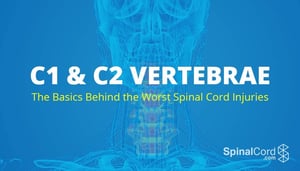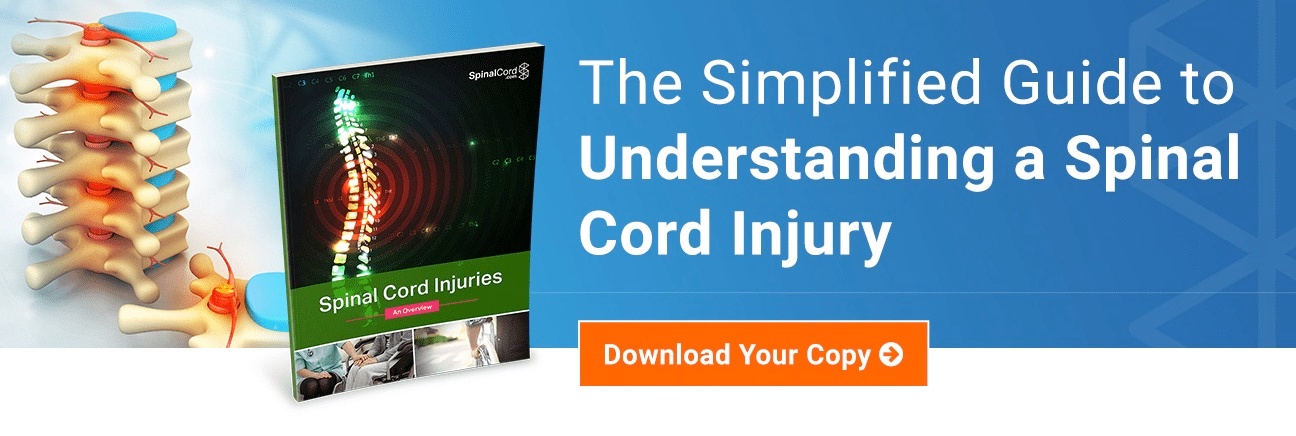Do You Know What Makes C2 Unique?
Everything You Demand to Know about C1 and C2 Vertebrae
Publish Appointment: December 02, 2020
For identification purposes, the spinal cord is divided into multiple sections that correspond with the vertebral section of the spine in that area. Read on for more information on the fundamentals of these injuries, expected prognosis, and the latest treatments available. The spine is made upwardly of 33 stacked bones called vertebrae. Medical professionals group these individual levels into 5 sections chosen: The vertebrae of the spinal column are responsible for protecting the spinal cord, which is a package of nerves that relays letters between the brain and the rest of the body. Together, the spine and spinal string are covered past a protective membrane, forming the spinal column. Spanning from the bottom of the skull to above the hips, the courage supports all forms of movement — getting upwardly, turning over in bed, continuing, running, and crouching. The start 24 vertebrae (working downwardly from the skull) are singled-out and mobile, simply the remainder toward the bottom of the spine are fused and remain stable. Fabricated of os, and held in identify with muscle and ligaments, the neck has the largest range of motion in comparison to other vertebrae. The seven vertebrae in the cervical region of the spine all work toward the same cause — moving the cervix and holding the skull in place. On boilerplate, the human head tin weigh betwixt 10 and xiii pounds, yet the bones in the cervical spine are the smallest of all the spine's vertebrae. However, the very first ii vertebrae, C1 and C2, have the most specialized jobs; allowing a unique gear up of movements for the skull. The cervical vertebrae C1 is fastened directly to the skull, which allows for any nodding lateral motions. The height foremost of the vertebrae, C1, allows for a greater range of motion than normal vertebrae. The C2 vertebra is the axis which the C1 vertebra pivots around and lets us move our skulls from side to side in a horizontal move. Like the C1 vertebra, a C2 vertebra has a greater caste of move than other vertebrae that are lower on the spinal cavalcade. Since the brain stem extends through the C1 and C2, information technology is extremely of import to the neurological system. The cervical vertebrae known as C1 and C2 form the top of the spine (neck) at the base of the skull. These vertebrae are uniquely shaped and take vertebral foramen (spaces within the os) which allow the vertebral arteries to reach through to the brain and supply it with blood. This vertebral formation is only seen in the cervical region. The C1 vertebra is referred to as atlas—and so named for the Greek myth in which the titan Atlas held up the sky. The second vertebra, C2, is called the axis in reference to its purpose — enabling motion. When together, atlas C1 and axis C2 permit for rotation and swiveling of the head since the C1 vertebrae is fastened direct into the skull and pivots from its C2 axis. The cervical spine is located at the very top of the spinal column. Besides the atlas C1 and axis C2 cervical vertebrae , at that place are 5 boosted vertebral levels within this region (for a total of vii) which are classified every bit C1-C7 from the height down, forming the homo neck. There is an additional cervical-level injury classification site known equally a C8 injury which relates to harm to the spinal string root that exits the spinal column between the C7 and T1 vertebrae. The cervical spinal string is the uppermost section of the fretfulness that are within of the neck vertebrae. This region of the spinal string, which is referred to by vertebral levels as C1-C7, is as well the most sensitive in the sense that injuries at this level are the most life-threatening. The vertebrae in this region, atlas C1 and axis C2 , back up your skull, allow y'all to plough and motility your head, and protect your spinal cord. To put it simply, higher the injury on the spinal string, the more damage and loss of function the private volition feel. Since the cervical spinal cord is the highest part of the spinal column, SCIs in this section of the spinal column tend to have the gravest furnishings. Considering the cervical spine is closer to the brain, and therefore affects a larger amount of the man body, spinal cord injuries that touch the atlas C1 and axis C2 sections of the spinal cord often result in death. For those who survive, these injuries often involve the loss of function to the neck and everything below information technology — which may result in full paralysis. Other related effects include the loss of ability to: When someone experiences consummate or fractional paralysis from the neck downwardly — their trunk and all four limbs — it is usually referred to as tetraplegia or quadriplegia. An injury to the cervical vertebrae C1 and a C2 spinal cord injury are both considered highly rare injuries to sustain. More common cervical spinal string injuries affect the C4 and C5 levels of the spinal column. Although injuries can occur at this level, they are not very common. Medical professionals meet more than injuries to the C4 and C5 expanse. The most frequent crusade of a C1 fracture is diving, followed by vehicular accidents, and then falls that impact the head. Atlas C1 and axis C2 injuries are the virtually severe because damage to the spinal cord at any level has potential to remove communication to the rest of the body below that point. Due to the high level and placing of these vertebrae at the top of the neck, having a C2 or C1 vertebrae out of place or suffering sustained damage is most ofttimes fatal (or leaves the individual fully paralyzed). In addition to the initial vertebral injury, the interference at the C1 and/or C2 level can cause the vertebral arteries to inflict neurological harm; leaving the brain without a vital source of blood. Symptoms following an injury to the cervical vertebrae C1 and C2 may include: Immediate treatment is crucial in the case of a cervical vertebrae C1 or C2 injury, and the caput must be deeply stabilized to prevent any further damage. It is likely that the person may have suffered a concussion, and so may be unable to accurately report pain. Keeping the head and neck in a constant position is 1 method of encouraging healing; one that is still in use today through various immobilization apparatuses, such equally hard-collars or halo vests. Depending on the injury, an individual may have to wear these medical devices for a number of months. The halo vest has been used for many years. However, more recently, it has been shown to be effective at preventing whatever further neurological injury in people with cervical spine injuries. Direct lateral mass screws are used to ensure no further movement of the vertebrae while preserving the upper cervical movement segments for the future. This surgical method has been extensively used, and studies have proven to be safe, with minimal complications and depression rate of morbidity for cervical myelopathy treatment. A person's ability to heal and recover some part after a cervical spinal string injury will vary from person to person depending on a diverseness of factors, including: People with these injuries also can get around with the help of ability wheelchairs that are equipped with special assistive technologies that allow them to control the chair's movement through unconventional means. Nonetheless, they will crave 24-60 minutes care and assistance from family, friends, and/or a professional caregiver. Spinal cord injuries are considered either incomplete or complete, pregnant that the communication between the spinal cord and the encephalon is either partially impeded or fully impeded. This could be due to tissue inflammation that is pressing confronting the spinal cord nerves, strange objects, or partial or complete severance of the cord itself. This can result in the fractional or total loss of motor and sensory functions beneath the injury site. When someone experiences complete or fractional paralysis from the neck down — their trunk and all four limbs — it is usually referred to as tetraplegia or quadriplegia. An injury to the cervical vertebrae C1 and C2 spinal cord injury are both considered highly rare injuries to sustain. More mutual cervical spinal string injuries touch on the C4 and C5 levels. The American Spinal Injury Association (ASIA) devised a scale, the ASIA Impairment Calibration, to allocate injuries based upon a combination of criteria to assess whether an injury is complete or incomplete. Farther information about completeness can be constitute by reviewing that scale.
While all spinal cord injuries (SCIs) can be dangerous and life-altering to the people who suffer them, there is ane diversity of spinal cord injury, in particular, that is considered the worst: an injury that falls within the cervical spinal cord — specifically at the C1 and C2 spinal cord injury level.
 Injuries to the cervical spine at the C1 and C2 vertebrae make upwards just two% of all spinal cord injuries. While they are considered the most severe of all spinal cord injuries, the effects of these injuries tin can vary depending on the abyss of the damage.
Injuries to the cervical spine at the C1 and C2 vertebrae make upwards just two% of all spinal cord injuries. While they are considered the most severe of all spinal cord injuries, the effects of these injuries tin can vary depending on the abyss of the damage. What Are Vertebrae?
What is a C1 Vertebra?
What is a C2 Vertebra?
C1 vs C2: Beefcake and Spinal Location
C1 and C2 Vertebrae Names
How Many Cervical Vertebrae Are In that location?
What Are the Functions of the Cervical Spinal Cord?
C1 and C2 Spinal String Injury Symptoms
Types of C1 and C2 Cervical Spinal Cord Injuries
C1 and C2 Vertebrae Breaks, Fractures, and Misalignments
Treatment for C1 and C2
C1 and C2 Spinal Cord Injury Recovery
Incomplete vs Complete Injuries

Topics: Spinal Cord Injury
Stay Updated on Advancements On Traumatic Encephalon &
Spinal String Injuries
Most the Author
Spinal Cord Team
The authors of Spinalcord.com are made upwardly of attorneys, those in the medical field, and survivors of spinal cord injuries or traumatic encephalon injuries. Learn more nigh our squad of authors including a brief biography that explains how they impact the SCI and TBI community.
Learn More Most the Writer
Source: https://www.spinalcord.com/blog/c1-and-c2-vertebrae-the-basics-behind-the-worst-spinal-cord-injuries
Belum ada Komentar untuk "Do You Know What Makes C2 Unique?"
Posting Komentar